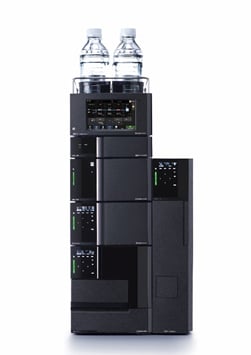Direct analysis of glyphosate, glufosinate and AMPA in beverages using LC-MS
Glyphosate and glufosinate are active ingredients in widely used foliar herbisides. When degraded in soil and water, glyphosate produces aminomethylphosphonic acid (AMPA) as a metabolite. Glyphosate, glufosinate and AMPA are all highly polar compounds, making retention in the reversed-phase mode with HPLC or LCMS difficult. Therefore, analysis usually employs derivatization using FMOC. This article introduces a method for a high-sensitivity measurement of glyphosate, glufosinate and AMPA that does not require complex pretreatment or time-consuming derivatization.
Analysis of Standard Solutions
We first performed MRM measurements of glyphosate, glufosinate and AMPA using the analytical conditions listed in Table 1. The chromatogram of each compound with a concentration of 5 μg/L is shown in Fig. 1 and the calibration curves are shown in Fig. 2. The accuracy and area repeatability (%RSD) of each calibration point are listed in Table 2. The accuracy of the calibration points are within 95.3 to 106.9 %.


Fig. 1 MRM Chromatograms of Glyphosate, Glufosinate and AMPA at 5 μg/L

Fig. 2 Calibration Curves of Glyphosate, Glufosinate and AMPA

Table 2 Accuracy (%) and Area Repeatability (%RSD, n=3) of each Calibration Point
Analysis of Beverages
Five types of beverages (coffee, tea, red wine, white wine, and apple juice) were filtered and the filtrates were spiked with glyphosate, glufosinate and AMPA to a concentration of 100 μg/L. Each sample was diluted with ultra pure water by a factor of 100 and then measured to determine spike recoveries. The resulting values are listed in Table 3.
As an example, the chromatograms of the coffee samples from the recovery tests are shown in Fig. 3. Pretreatment of samples often includes a clean-up method such as solid-phase extraction. However, procedures are complex and the work load and cost are drawbacks. The method described in this article features very simple pretreatment procedures comprising only filtering and dilution while achieving favorable recoveries ranging from 72.9 to 104.9 % with actual samples.

Table 3 Recovery (%) and Area Repeatability (%RSD, n=3)

Fig 3. MRM Chromatograms of Spike and Recovery Test Samples (Coffee)



